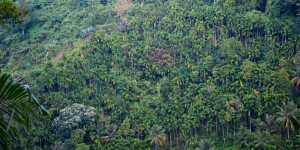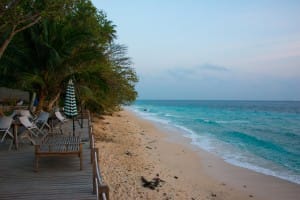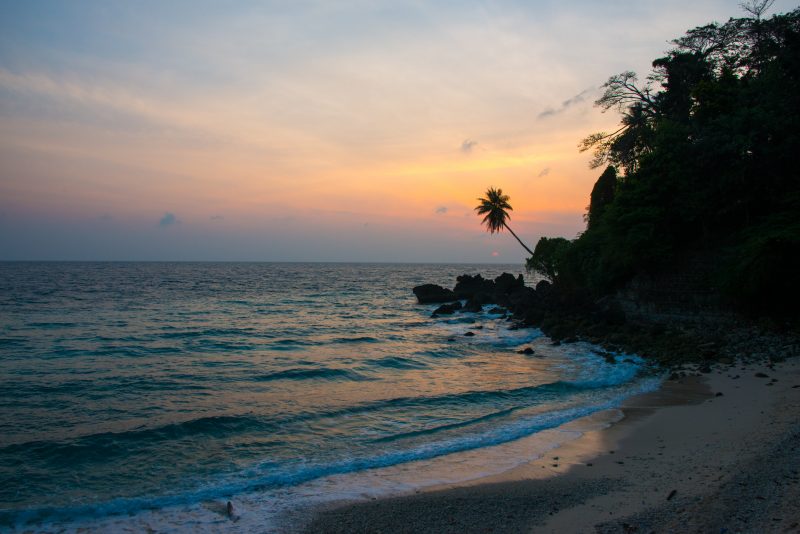A small tropical treasure trove of peace and adventure can be found tucked away in Aceh’s far north, at the north-westernmost edge of the Indonesian archipelago. Weh Island is a small active volcanic island with a fringe of magical beaches, colourful corals, and rich marine life, just 45 minutes by fast boat from the gateway city of Banda Aceh.
I found my way to Casa Nemo Bungalow Resort & Spa in Sumur Tiga Beach and by late afternoon I was relaxing in my comfortable bungalow hammock, gazing out at the Andaman Sea. Cloaked in lush green forests, Weh brims with secret delights. Aside from diving, underwater hot springs, gorgeous waterfalls and high mountain trails wait to be discovered.
The local Acehnese people add an air of charm to this friendly, welcoming tropical isle. Most tourists who find their way to Weh are adventurous travellers in search of a remote, island experience. The reward for travelling this far? An easy, slow-paced and completely stress-free holiday experience.
I spent my first day discovering the beautiful bays and beaches of Weh by motorbike – the best way to cruise around and explore the island. The highlight of the day was hitting the big zero, the spot made famous for marking the physical beginning of Indonesia. A zero as tall as a football goalpost is positioned at Weh’s westernmost point, aptly named Kilometre Zero. It makes for a popular meeting point for locals and foreigners alike at 6pm, when the sun drops off the edge of Indonesia.
I ordered a sundowner at the warung and got talking to the locals, who told me there is a spot in Papua marking the easternmost point of Indonesia. A lively discussion developed among the warung’s patrons: what was the exact number written on the kilometre sign at the eastern end of Indonesia’s chain of islands? Most agreed was around 5,300 kilometres, but no one really knew. Most locals don’t venture very far from Weh Island.
 Suddenly, I heard the whirr of a machine and papers shuffling. The clever shop owner had a little side business: spitting out of a printer were bright yellow certificates with beautiful gold lettering. Each were individually numbered and signed by the Mayor of Sabang (the main port town on Weh Island). How could I resist? I requested one for a keepsake, pleased to see on inspection I was visitor number 91,743.
Suddenly, I heard the whirr of a machine and papers shuffling. The clever shop owner had a little side business: spitting out of a printer were bright yellow certificates with beautiful gold lettering. Each were individually numbered and signed by the Mayor of Sabang (the main port town on Weh Island). How could I resist? I requested one for a keepsake, pleased to see on inspection I was visitor number 91,743.
Next up, a discovery tour of the island to find out what lies beneath the diamond-strewn waters of Weh. I discovered there were 20 dive spots around the island, with Gapang beach and its house reef the most popular.
The marine life is prolific, and Marjan van der Burg, owner of Lumba Lumba Dive Centre, explained to me that local people keep the sea gardens protected in the traditional way. “Diving keeps the economy afloat here,” she explained.
“Each village takes responsibility to protect their local patch of marine environment. If an outside boat comes into a villager’s territory and is engaging in any sort of destructive fishing practice, like coral crushing or illegal dynamite blasting, the village takes action immediately. By law, they can confiscate the offender’s boat for one week and impose a fine. If the fisherman offends a second time, they can burn the boat.” This strong local social village structure keeps offenders away. According to van der Burg, this has resulted in wonderfully prolific sea life and pristine coral seabeds.
Weh’s bounteous marine life includes scores of scorpion fish, lionfish and blue spotted rays. Even giant whale sharks are known to swim through these plankton-rich waters. Rubiah Island, which sits a very short distance from the shores of Lumba Lumba Dive Centre, has unique coral gardens that are home to black spotted and honeycomb morays. Divers can explore the Rubiah wall, which drops down 30 metres.
After a full day’s diving, head back to Gapang Beach to try the local Acehnese food, which packs in the spice. More classic Indonesian dishes are also available and some basic Western food like pancakes, sandwiches and fries. Mama Jungles is a favourite family-style restaurant located right on the beach.
For non-divers there’s plenty to do on Weh Island. Transport is easy to find and very reasonably priced. Keen explorers can arrange a motorbike or car from your homestay, bungalow retreat or dive stay. Head into the interior to hike jungle trails, swim in Danau Anak Lauta (a serene freshwater lake) or climb Gunung Merapi, a semi-active stratovolcano. In between the sights along the narrow, winding island roads you’ll encounter quaint little villages habited by welcoming farmers.
 The island’s low-key yet adventure-ready vibe, together with the richness of its sea gardens and genuine Acehnese hospitality, makes Weh Island a real Sumatran gem.
The island’s low-key yet adventure-ready vibe, together with the richness of its sea gardens and genuine Acehnese hospitality, makes Weh Island a real Sumatran gem.
Underwater Nightlife
Lumba Lumba Dive Centre offers amazing night dives at Gapang House Reef. See colourful nudibranchs, ghost pipefish, symbiotic shrimps, octopus, frogfish and squat lobsters. If night dives don’t tickle your fancy, try a day dive with the beach’s three resident turtles. All you need are fins and a snorkel and you can swim with them in only a couple of metres of water. http://www.lumbalumba.com
Rainforests on a Mountain Bike
If you can tear yourself away from the beaches, renting a bike and touring through the rainforest is a great way to experience the island’s natural diversity and get some exercise too. The roads are relatively traffic-free so you can cycle in peace and solitude. An easy 30km ride will take you through a good chunk of the island and reveal beautiful coastal scenery.
Sea Breezes and Wildlife
You can easily spot monitor lizards, monkeys, sea eagles, kingfishers and other tropical birds from the Lumba Lumba Dive Centre garden. Coupled with salty sea air is the smell of lush foliage, as large overhanging gapang trees surround part of the beach.
Dining Out
The taste sensations at Casa Nemo Bungalow Resort & Spa on Sumur Tiga Beach include a complete menu of authentic Acehnese dishes. At the top of the list is the delicious curry (fish or meat) called Gule Aceh. Try Ikan Kayu, a dried tuna dish cooked in a light curry sauce. Rendang Gurita sam Keuung is a local octopus dish cooked for six hours in coconut milk, herbs and spices, and another favourite Plie U is a tasty vegetable soup topped with dry coconut. Western tastes are catered for as well with bakery items, pastry and breads, thin crust pizza and fine espresso coffee. http://www.casanemo.com
Accommodation
Casa Nemo Bungalow Resort & Spa is located on the beautiful white sandy shoreline of Sumur Tiga Beach and offers snorkelling right outside the door of your bungalow. It is a family-run resort, with your gracious hosts Gianluca and Balqist providing excellent service and beautiful food. Gianluca goes to the local fish market very early every morning, so you are guaranteed to have fresh seafood daily. Accommodation is in customary Acehnese house style. Performances of traditional music and dance take place every Saturday night. http://www.casanemo.com




